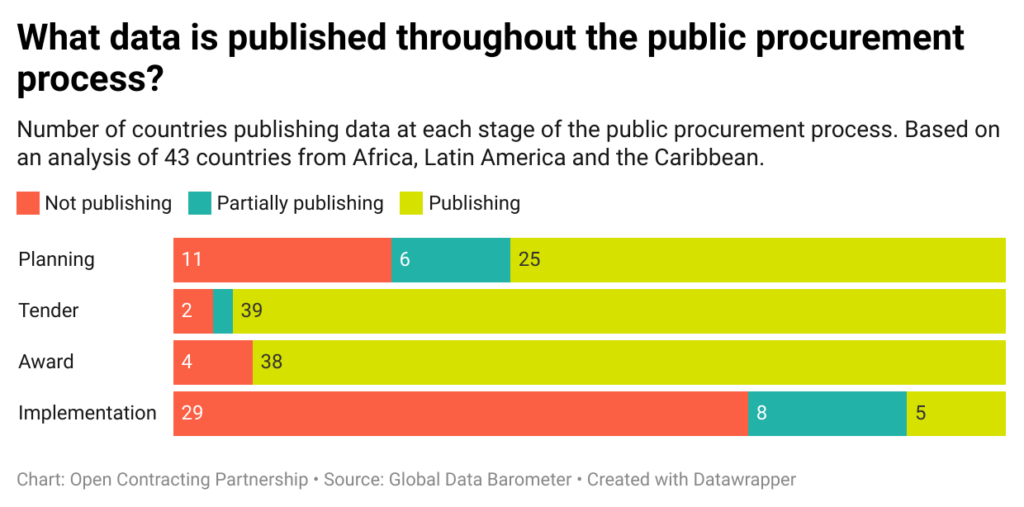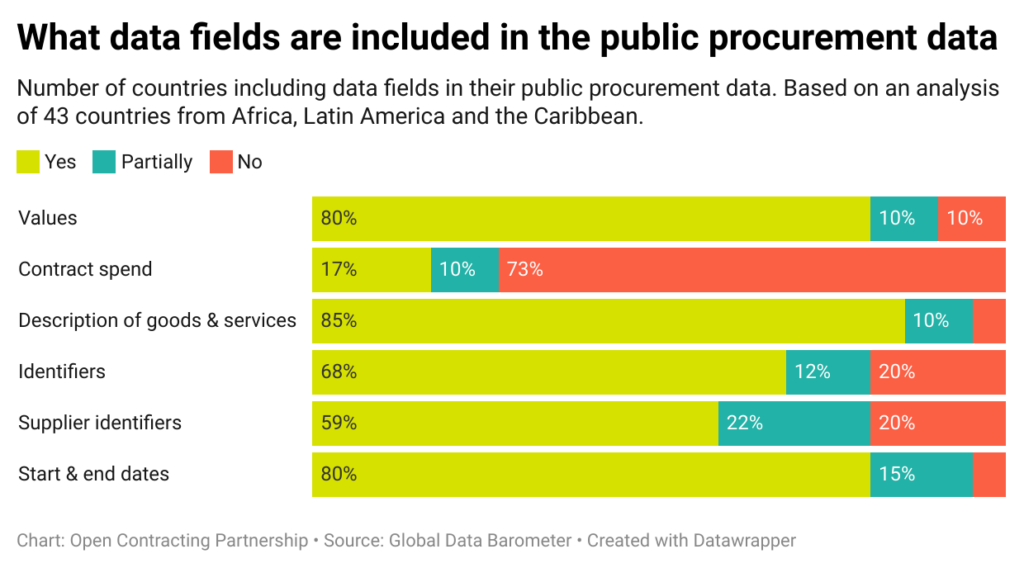Insights from the 2025 Global Data Barometer: How are Africa, Latin America and the Caribbean doing on public procurement

Public procurement data is the most widely available cluster of data included in the latest Global Data Barometer. This is encouraging since public contracting is the world’s largest marketplace, covering $13 trillion of spending every year. Given its scope and scale, effective management of procurement is critical to addressing many of the world’s most significant challenges, from climate change to inequality.
41 out of 43 countries in Africa, Latin America and the Caribbean in this year’s Barometer publish some government procurement data online. Half of them (21) release it in machine-readable formats; 16 countries make machine-readable data available as a whole through bulk downloads or APIs. Champions like Paraguay publish data in machine-readable formats across the full procurement process from planning to implementation. Latin American countries Chile, Ecuador, and Peru and in Africa countries like Kenya and Nigeria also score high on availability. We’ve worked intensively with partners in each of these countries and it’s great to see the Barometer reflecting the positive impact of that collaboration.
So let’s dive in and find out more who’s doing well and who needs to try harder to share this vital public dataset.
The bright spots
The good news is that all of the countries assessed have laws, policies or regulations requiring the collection and publication of this information. In Latin America, countries such as Chile, Ecuador, Paraguay, and the Dominican Republic in the Caribbean demonstrate good data availability, combined with a legal framework that specifically supports the collection and publication of procurement data.
In Africa, data availability lags behind legislation, but the results reflect some notable progress made in the region in developing stronger legal frameworks that guide data collection requirements. Uganda, Kenya, South Africa and Rwanda lead with scores above 80.
| Country | Region | Overall score | Availability | Governance |
| Chile | Latin America and the Caribbean | 95.21 | 96.67 | 93.75 |
| Ecuador | Latin America and the Caribbean | 93.75 | 97.5 | 90 |
| Paraguay | Latin America and the Caribbean | 93.44 | 100 | 86.88 |
| Uganda | Africa | 92.38 | 84.75 | 100 |
| Mexico | Latin America and the Caribbean | 90.63 | 92.5 | 88.75 |
| Dominican Republic | Latin America and the Caribbean | 90.53 | 94.17 | 86.88 |
| Peru | Latin America and the Caribbean | 88.54 | 95.83 | 81.25 |
| Kenya | Africa | 88.34 | 89.17 | 87.5 |
| South Africa | Africa | 87.76 | 83.63 | 91.88 |
| Colombia | Latin America and the Caribbean | 87.71 | 94.17 | 81.25 |
| Panama | Latin America and the Caribbean | 86.51 | 87.38 | 85.63 |
| Rwanda | Africa | 81.20 | 71.76 | 90.63 |
Machine-readable data
In Latin America, two-thirds of countries (15 out of 21 countries or 68%) assessed have machine-readable data available and 11 publish it using the Open Contracting Data Standard (OCDS), a free, non-proprietary open data standard for public contracting managed by OCP.
In Africa, only one in four countries (6 out of 22 countries or 27%) assessed have machine-readable data available and publish their data in OCDS: Ghana, Kenya, Nigeria, Rwanda, South Africa, and Uganda.
This limits effective oversight and holds back efficient use of data-driven analysis and technology. Using data on public procurement systematically can help governments deliver better value for money and increase efficiency, prevent and uncover corruption, strengthen competition, and better track service delivery.
Coverage of procurement phases
The report identifies gaps in the information published and the stages of the procurement process covered. In most countries, only data from the tender and award stages is available (more than 90%). While 60% publish data on the planning stage, just six countries publish some details about contract implementation.

Top data fields: Items purchased, tender values and dates
This year, the Global Data Barometer also analyzes which data fields are included in the published data.
It finds that most countries have information on the goods and services being procured, the values of the tender, awards or contracts, and the dates of the procedures. However, key data fields that would allow users to connect procurement data to other data sets, such as identifiers that connect data across the different stages of the procurement process (68.3%) or the names and unique identifiers for companies that are awarded contracts (58.5%), are only available in half of the countries. Data on actual spending against each contract in the implementation phase is only available for every seventh country (17%).

What’s next: closing gaps and moving from law to practice
While there are good examples in both regions of how to disclose procurement data in an open format, following international best practices, there are still significant gaps in the disclosure across all stages of the contracting process in a machine-readable format.
The sheer volume of transactions in public contracting means that data and documents about contracts are significantly easier to analyze and track if they are published in an open, accessible, structured, reusable and machine-readable format. For example, in countries that publish standardized open contracting data, corruption risk indicators can be calculated using OCP’s Red Flags guide. This red flags methodology has been used to build analytics tools and implement civic monitoring initiatives to achieve greater public integrity.
In Africa particularly, legislation mandating the collection and publication of data is ahead of implementation. More investment is needed in implementing e-procurement systems that digitalize the procurement process and collecting data to comply with the regulations. Countries like Kenya, Rwanda, South Africa and Uganda show that doing better is possible even with fewer resources, for example by prioritizing local development of e-procurement systems. And where the use of e-procurement systems is made mandatory, data coverage improves. Our Open Contracting Legislative Guide offers advice and best practice examples on implementing e-procurement effectively.
The results of the latest Global Data Barometer reiterate that all countries have work to do to ensure they are making the most of their public procurement information. As data availability and quality continue to improve, so do the opportunities for all stakeholders to use public procurement data to deliver better public services, goods and infrastructure for inclusive, fair and sustainable communities.